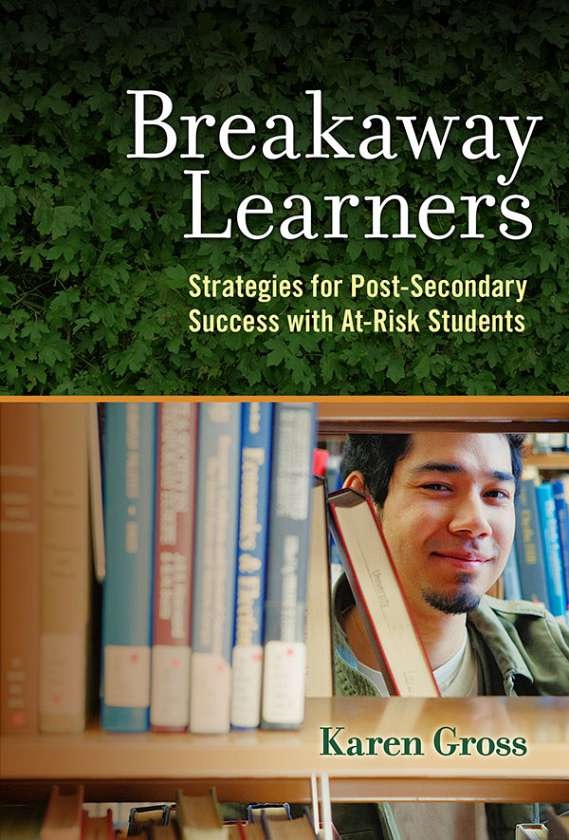student learning
Select an item by clicking its checkbox

Breakaway Learners Strategies for Post-Secondary Success with At-Risk Students
Date Reviewed: December 12, 2017
Two root words for education, educare and educere respectively express the complementary principles, to train or mold, and to lead out from. Of the two root words, Karen Gross’s book exemplifies educere, to lead out from, since her basic premise is to meet “students where they are and asks – demands – that institutions do vastly more to understand and respond to the students now enrolled in our educational system” (15). More than a student-centered learning approach to education, Gross suggests that the educational system as a whole should assist students in developing lasticity, a term she uses to describe the quality necessary to enable breakaway students not only to complete their degrees, but also to succeed as adults in the working environment.
Gross prefers the term “breakaway learners” rather than “at-risk learners” because it describes more accurately that these students are breaking away from the societal, economic, and familial circumstances that often have hindered their progress in the educational system. She notes that these students have developed the capacity, often overlooked, for lasticity. She defines lasticity as a set of conditions that enables individuals to flourish in education and life. Lasticity is built upon a two-part equation of six qualities (the six Ts) and five building blocks. While she does explain the six Ts (trust, transparency, tranquility, teachers and teaching, tolerance, and temperance), Gross focuses mostly upon the five building blocks of elasticity, plasticity, pivoting right, reciprocity, and belief in self. Within her chapters, she provides clear examples of each of these five building blocks, noting that the first three are centered on the students themselves, whereas the last two require engagement between students and institution. For example, her chapter “Pivoting Right,” while centering on the individual, does describe four ways educators can foster making wise decisions.
While Gross addresses developing lasticity in higher education, she also notes that the educational system as a whole, from early childhood to college, requires a re-examination of its purpose and goals. As such, Gross recognizes the challenge of changing the educational pipeline and landscape that would enable the development of lasticity. She identifies both macro and micro challenges that need to be surmounted. Further, she addresses the hurdle of money and provides suggestions as to how to assist students better, even to the recommendation of changing the FAFSA form itself to make it more accessible to all parents and students.
Even though her text focuses on changing the educational pipeline, some of her examples can be used now by educators and within institutions. Developing trust, enabling student voices, and encouraging belief in self can be done in many of the ways she suggests as well as through understanding better those whom we help learn along the journey of life. In essence, Gross would probably agree that the process begins with changing the focus of education from educare to educere.
Mr. Sosnow, my fourth-grade teacher, interrupted the class as we copied our homework assignments into our black-and-white marble composition books from the chalkboard. With a sly look in his eye, Mr. Sosnow informed the class that he had a special homework assignment for us. He instructed us that by tomorrow, ...
Is my teaching good enough? Is your teaching good enough? I believe that good enough teaching and learning are practices of radical hospitality that are needed more than ever today in a political climate of American exceptionalism, increasingly divisive civil discourse, and passionate if conflicting longings to be “great.” While ...

Enhancing Student Learning and Development in Cross-Border Higher Education (New Directions for Higher Education, Number 175)
Date Reviewed: October 18, 2017
This volume is dedicated to cross-border education, a type of internationalization focused on education strategies that move across national and regional lines. Editors Roberts and Komives cite J. Knight’s description of internationalization as “the process of integrating an international, intercultural, or global dimension into the purpose, functions, or delivery of postsecondary education” (10). Internationalization, at first blush, may appear but a mere euphemism for globalization, a rather deleterious concept especially when partnered with education. Roberts and Komives, however, are quick to point out how internationalization differs from globalization in both purpose and process. Globalization promotes rampant product production, increased uniformity, the ubiquity of certain products and hegemonic narratives, and is often associated with the pernicious effects of the exploitation of vulnerable populations around the world. In contrast, “internationalization is a process of infusing international ideas across a variety of functions and experiences” in which “distinct attributes of identity are accorded value” (10). Internationalization, according to Roberts, “embraces the inevitable – a shrinking planet with growing shared reliance on each other” but also seeks to preserve culture (10). Cross-border education (CBE) goes beyond the traditional study abroad mindset; it requires “infusing international, cultural, or comparative perspectives in existing courses,” “modifying teaching and learning processes through virtual experiences,” and incorporating scholarship from other cultural settings to bring the world “home” to students within their own schools (16). It also encourages fluidity of people, programs, projects, and policies across national and regional lines and places a high premium on critical analysis of the cross-cultural application of educational practices.
Section one addresses how to systematically study educational practices and evaluate their transferability to a different context. Darbi Roberts’ contribution requires readers to address how and why educational systems choose from which programs to borrow. Section two illustrates examples of student learning and development programs around the world (South Africa, China, UK, Mexico, and more) created to address specific populations and needs within their own cultural and national boundaries but which may prove incredibly useful for others throughout the world. Previously, much research on student learning and development originated in the United States, but this volume highlights the growing programs in other parts of the globe. McGlory Speckman writes about first-year village programs in South Africa, where this program was developed, and the need of many students from backgrounds of “economic, social, and political deprivation” for a communal and supportive environment as they transition to a university setting (34). Wong’s chapter is a fascinating foray into a unique population in China, students born under China’s 1979 One Child Policy, whose disruptive adjustment to university life requires universities to set up programs addressing this population’s lack of compromising skills and enhance their resiliency and self-reliance. These programs include everything from complicated team work, physical training, and mentorship to a simulation activity called the “city challenge” in which “students are given very limited pocket money and they have to earn their food by selling products they invent” (45). Chapter 5 focuses on a specific program at the University of Sheffield, UK, dedicated to “looked-after children” and “care leavers” (49). Encouraging this population towards higher education is a real challenge, as “only around 6% of English care leavers enter higher education at the age of 19, compared to 48% of a similar age in the general population” (53). Mexico’s legacy of political corruption, financial disparity between rich and poor, and a general lack of civically engaged citizens have created a challenging environment for local universities trying to educate their students to become leaders, according to Alicia Canton’s chapter. The Universidad de Monterrey (UDEM) has invested in numerous initiatives to encourage students to become involved in their communities such as implementing active pedagogies “connecting the student to current problems within the local community,” requiring every student to complete an internship at a local organization, offering cocurricular courses to develop leadership competencies, and mandating “every student perform 480 hours of service” (59-60).
Section III moves readers back into the realm of theory, providing analytical tools for exploring data produced in specific student learning and development environments like those described in Section II. This section exemplifies how those designing initiatives to enhance student learning and development, especially in the arena of cross-border education (CBE), must explore the significance of context as well as content. Readers are prompted to explore prevalent cultural assumptions, national agendas, and various socio-political discourses which have informed and shaped their own definitions of learning and development, as well as those of the programs they wish to adopt or adapt. Broido and Schreiber’s chapter presents social justice frameworks for student learning and development as well as concise renderings of various pertinent dimensions of student development theories (identity development, cognitive-structural development, and self-authorship theories). Drawing on the work of Hofer and Weinstock, Broido and Schreiber note how “patterns of epistological development vary among cultures” and how cultural assumptions about knowledge, truth, and authority, can profoundly affect how students learn and develop (70). The general values of a culture “as well as the role of the family, religion, and social identity enhances a critical perspective on designing appropriate strategies for student learning and development” (75). Chapter 8 applies an ecological systems view to Singapore, a culture that highly values formal education, an attribute likely stemming from a belief among families that education is a passport out of poverty. Deference to elders and authority, possibly arising from a Confucian root in the culture, are attributes which lead to a particular learning environment, not unique to Singapore but definitely significant when considering program adoption across borders. Chen’s and Mathies’ contribution looks at increased interest in assessment and evaluation in the halls of higher education, in the U.S. and around the world, over the last few decades. The fact that college admission in many Asian cultures is controlled by the government via a national entrance exam, exemplifies just another way in which U.S., European, and Asian institutions approach education differently (89). Formerly faculty and now on staff as an academic advisor, I fully concur with the authors of chapter 10 that “in a cross-border educational paradigm, it is increasingly important for faculty and staff to orient their work and self-understanding of their roles to be that of educators” (93). The need for internationally competent staff will only become more critical in the future.
Roberts and Komives close their volume with a look at how partnerships can enhance student learning and development by taking into consideration institutional motivations for transferring, adapting, hedging, or even avoiding certain programs or policies. Some aspects of student learning and development programs (such as career decision making, counseling, intercollegiate sports, student governance, fraternities and sororities, coed housing, and so forth) may work well in the “home” country but prove disastrous when transplanted into another environment. This volume will prove illuminating to any student affairs professional, academic advisor, study abroad or exchange coordinator, faculty, or administer within higher education today but it is especially germane to those directly or even tangentially involved with policy adoption across borders.

Non-Cognitive Skills and Factors in Educational Attainment
Date Reviewed: October 18, 2017

